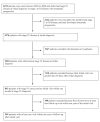Incidence of severe pain in newly diagnosed ambulatory patients with stage IV cancer
- PMID: 23061086
- PMCID: PMC3465096
- DOI: 10.1155/2012/542354
Incidence of severe pain in newly diagnosed ambulatory patients with stage IV cancer
Abstract
Background: Pain is common among cancer patients.
Objective: To characterize the incidence of severe pain among newly diagnosed patients with stage IV cancer in ambulatory care.
Methods: A retrospective cohort of 505 ambulatory oncology patients with newly diagnosed stage IV solid tumours at a comprehensive cancer centre (Dana-Farber Cancer Institute, Boston, Massachusetts, USA) was followed from January 1, 2004, to December 31, 2006. Pain intensity scores were extracted from electronic medical records. The incidence of severe pain was calculated using the maximum monthly pain scores reported at outpatient visits.
Results: Of the 505 patients included in the present study, 340 (67.3%) were pain-free at the initial visit, 90 (17.8%) experienced mild pain, 48 (9.5%) experienced moderate pain and 27 (5.4%) experienced severe pain. At least one episode of severe pain within one year of diagnosis was reported by 29.1% of patients. Patients with head and neck, gastrointestinal and thoracic malignancies were more likely to experience severe pain compared with patients with other types of cancer (52.6%, 33.9% and 30.5%, respectively). In the multivariable model, patients whose primary language was not English (OR 2.90 [95% CI 1.08 to 7.80]), patients who reported severe pain at the initial visit (OR 9.30 [95% CI 3.72 to 23.23]) and patients with head and neck (OR 10.17 [95% CI 2.87 to 36.00]) or gastrointestinal (OR 4.05 [95% CI 1.23 to 13.35]) cancers were more likely to report severe pain in the following year.
Conclusions: The incidence of severe pain was high in ambulatory patients with newly diagnosed stage IV cancer.
HISTORIQUE :: La douleur est courante chez les patients cancéreux.
OBJECTIF :: Caractériser l’incidence de douleur sévère chez les patients en soins ambulatoires atteints d’un cancer de phase IV nouvellement diagnostiqués.
MÉTHODOLOGIE :: Les chercheurs ont suivi une cohorte rétrospective de 505 patients en oncologie ambulatoire ayant des tumeurs solides de phase IV nouvellement diagnostiquées qui fréquentaient un centre de soins complets du cancer (le Dana-Farber Cancer Institute de Boston, au Massachusetts, États-Unis) du 1er janvier 2004 au 31 décembre 2006. Ils ont extrait les indices d’intensité de la douleur des dossiers médicaux électroniques. Ils ont calculé l’incidence de douleur sévère au moyen des indices de douleur mensuelle maximale déclarés lors des visites en consultations externes.
RÉSULTATS :: Sur les 505 patients inclus dans la présente étude, 340 (67,3 %) ne ressentaient pas de douleur lors de leur visite initiale, 90 (17,8 %) ressentaient une douleur légère, 48 (9,5 %), une douleur modérée et 27 (5,4 %), une douleur sévère. Dans l’année suivant le diagnostic, 29,1 % des patients ont déclaré au moins un épisode de douleur sévère. Les patients ayant des tumeurs malignes de la tête et du cou, du système gastrointestinal ou du système pulmonaire étaient plus susceptibles de ressentir des douleurs sévères que ceux ayant d’autres types de cancer (52,6 %, 33,9 % et 30,5 %, respectivement). Dans le modèle multivariable, les patients dont la langue maternelle n’était pas l’anglais (RRR 2,90 [95 % IC 1,08 à 7,80]), les patients qui avaient déclaré une douleur sévère à la première visite (RRR 9,30 [95 % IC 3,72 à 23,23]) et ceux ayant un cancer de la tête et du cou (RRR 10,17 [95 % IC 2,87 à 36,00]) ou du système gastro-intestinal (RRR 4,05 [95 % IC 1,23 à 13,35]) étaient plus susceptibles de déclarer une douleur sévère au cours de l’année suivante.
CONCLUSIONS :: L’incidence de douleur sévère était élevée chez les patients ambulatoires ayant un cancer de phase IV nouvellement diagnostiqué.
Figures


References
-
- Goudas LC, Bloch R, Gialeli-Goudas M, et al. The epidemiology of cancer pain. Cancer Invest. 2005;23:182–90. - PubMed
-
- Mantyh PW. Cancer pain and its impact on diagnosis, survival and quality of life. Nat Rev Neurosci. 2006;7:797–809. - PubMed
-
- van den Beuken-van Everdingen MHJ, de Rijke JM, Kessles AG, Schouten HC, van Kleef M, Patijn J. Prevalence of pain in patients with cancer: A systematic review of the past 40 years. Ann Oncol. 2007;18:1437–49. - PubMed
-
- Breivik H, Cherny N, Collett B, et al. Cancer-related pain: A pan-European survey of prevalence, treatment, and patient attitudes. Ann Oncol. 2009;20:1420–33. - PubMed
Publication types
MeSH terms
LinkOut - more resources
Full Text Sources
Medical
Miscellaneous

